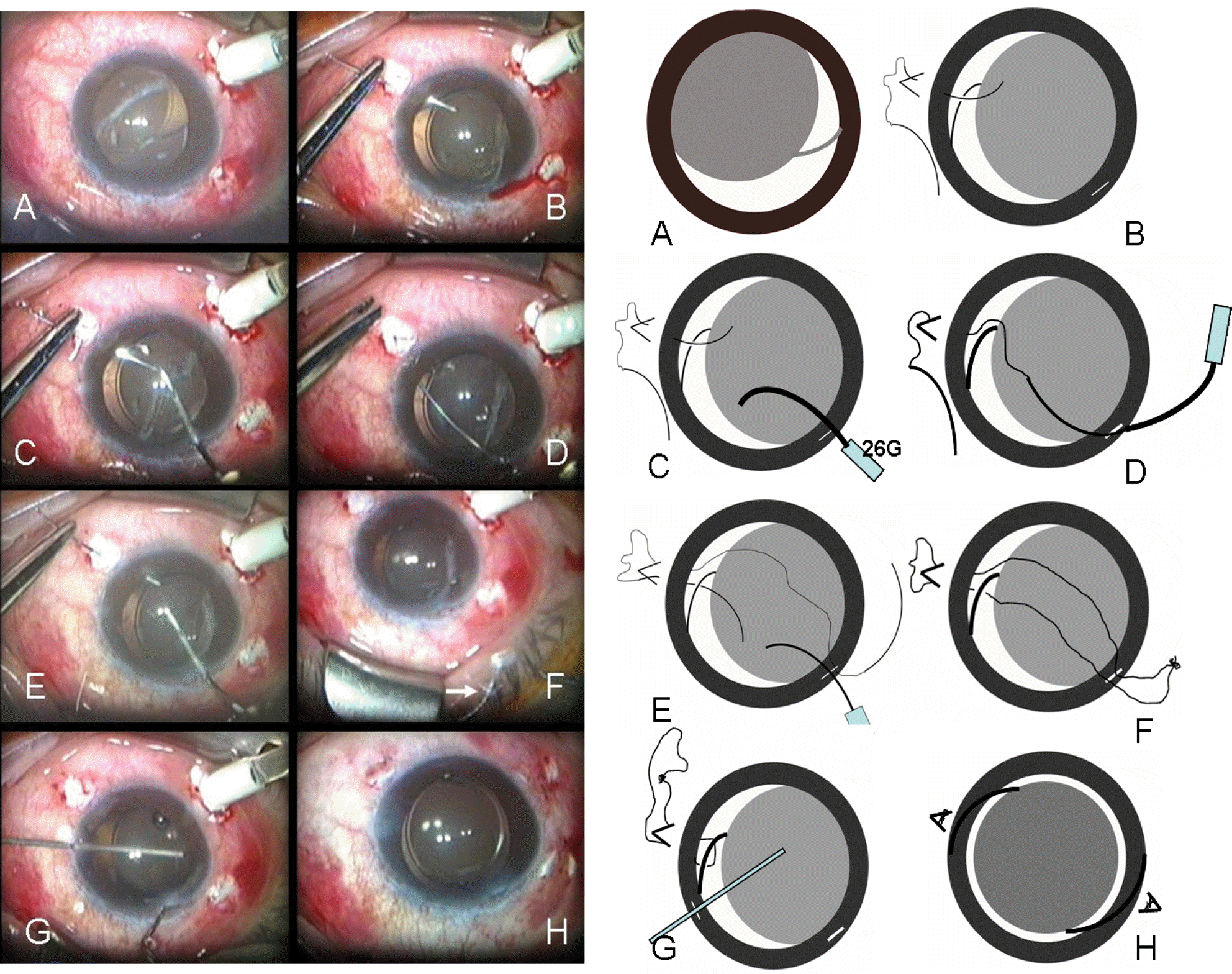Abstract
Purpose
To report the clinical effects of reverse ab externo scleral fixation with scleral penetration using a 10-0 prolene needle in patients with dislocation of a posterior chamber intraocular lens (PCIOL).
Methods
The ab externo scleral fixation technique uses a corneal tunnel and a loop of 10-0 propylene made by 2 consecutive scleral sutures to fix the haptic to the sclera. The reverse technique penetrates the sclera with a 10-0 prolene needle instead of a 26-gauge needle and introduces the 26-gauge needle into the corneal tunnel to pull the 10-0 prolene needle through, thus creating a loop around the haptic and fixing it to the sclera. Scleral fixation was performed on one haptic in 2 eyes and on both haptics in 3 eyes.
Results
The dislocated IOLs were successfully repositioned, and the corrected visual acuity was improved postoperatively in all 5 eyes. There was no specific complication except mild hyphema in 1 eye. Conclusions: Reversed ab externo scleral fixation is an easy and effective way to reposition dislocated PCIOLs and decrease the complication of hemorrhage and hypotony frequently associated with the standard ab externo technique.
References
1. Stark WJ Jr, Maumene AE, Datiles M, et al. Intraocular lenses: complications and visual results. Trans Am Ophthalmol Soc. 1983; 81:280–309.
2. Smith SG, Lindstrom RL. Malpositioned posterior chamber lenses: etiology, prevention, and management. J Am Intraocul Implant Soc. 1985; 11:584–91.

3. Jehan FS, Mamalis N, Crandall AS. Spontaneous late dislocation of intraocular lens within the capsular bag in pseudoexfoliation patients. Ophthalmology. 2001; 108:1727–31.

4. Carlson AN, Stewart WC, Tso PC. Intraocular lens complications requiring removal or exchange. Surv Ophthalmol. 1998; 42:417–40.

5. Chan CC, Crandall AS, Ahmed II. Ab externo scleral suture loop fixation for posterior chamber intraocular lens decentration: clinical results. J Cataract Refract Surg. 2006; 32:121–8.

6. Koh HJ, Kim CY, Lim SJ, Kwon OW. Scleral fixation technique using 2 corneal tunnels for a dislocated intraocular lens. J Cataract Refract Surg. 2000; 26:1339–41.

7. Cho SH, Kang SW, Jung MS. Four cases of modification of scleral fixation using 30 G needle for posterior chamber intraocular lens dislocation. J Korean Ophthalmol Soc. 2002; 43:917–21.
8. Smiddy WE. Dislocated posterior chamber intraocular lens; a new technique of management. Arch Ophthalmol. 1989; 107:1678–80.
9. Shin DH, Hu BV, Hong YJ, Gibbs KA. Posterior chamber lens implantation in the absence of posterior capsular support. Ophthalmic Surg. 1988; 19:606–7.
10. Mensiz E, Aytuluner E, Ozerturk Y. Scleral fixation suture technique without lens removal for posteriorly dislocated intraocular lenses. Can J Ophthalmol. 2002; 37:290–4.

Figure 1.
(A) A dislocated posterior chamber intraocular lens (PCIOL). (B) One of the curved needles of a double-armed 10-0 prolene is introduced into the ciliary sulcus 1.5 mm posterior to the limbus under the triangular scleral flap, positioned above the haptic and the optic of the dislocated IOL. (C) A bent 26-gauge needle is introduced through the corneal stab wound. (D) One needle of a double-armed 10-0 Prolene suture was captured by the 26-gauge needle and pulled out through the corneal stab wound. (E) The other end of a double-armed 10-0 Prolene is reintroduced in the same manner 1.0 mm adjacent to the previous td site and placed it beneath the haptic and above the optic of the dislocated IOL and a bent needles, both ends of 10-0 Prolene (arrow) are tied and the whole 10-0 Prolene loop is pulled out through the opposite scleral suture. (G) Capsular remnant and prolapsed vitreous are removed using 25-gauge vitreous cutter. (H) Well-centered PCIOL.





 PDF
PDF ePub
ePub Citation
Citation Print
Print


 XML Download
XML Download